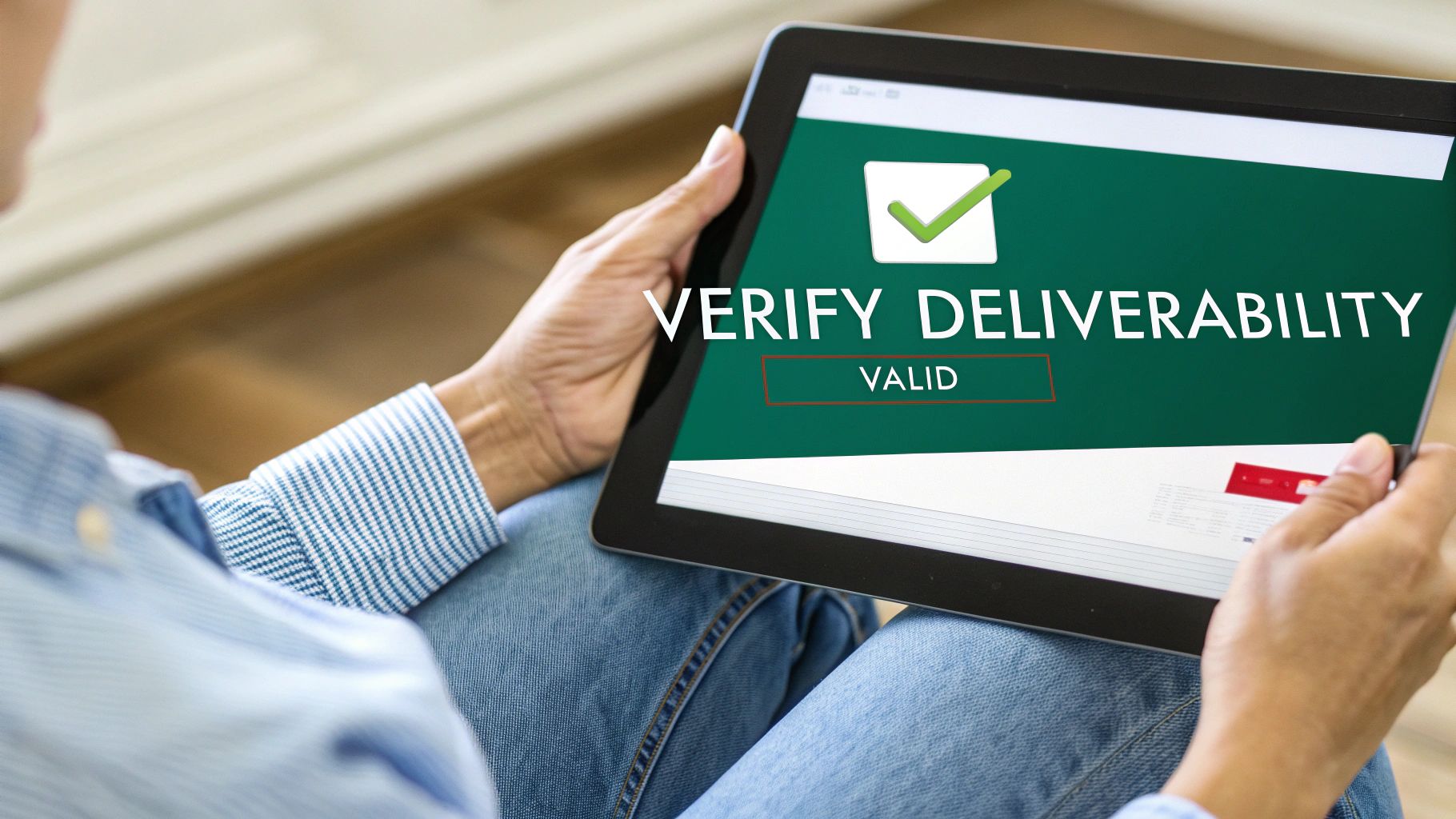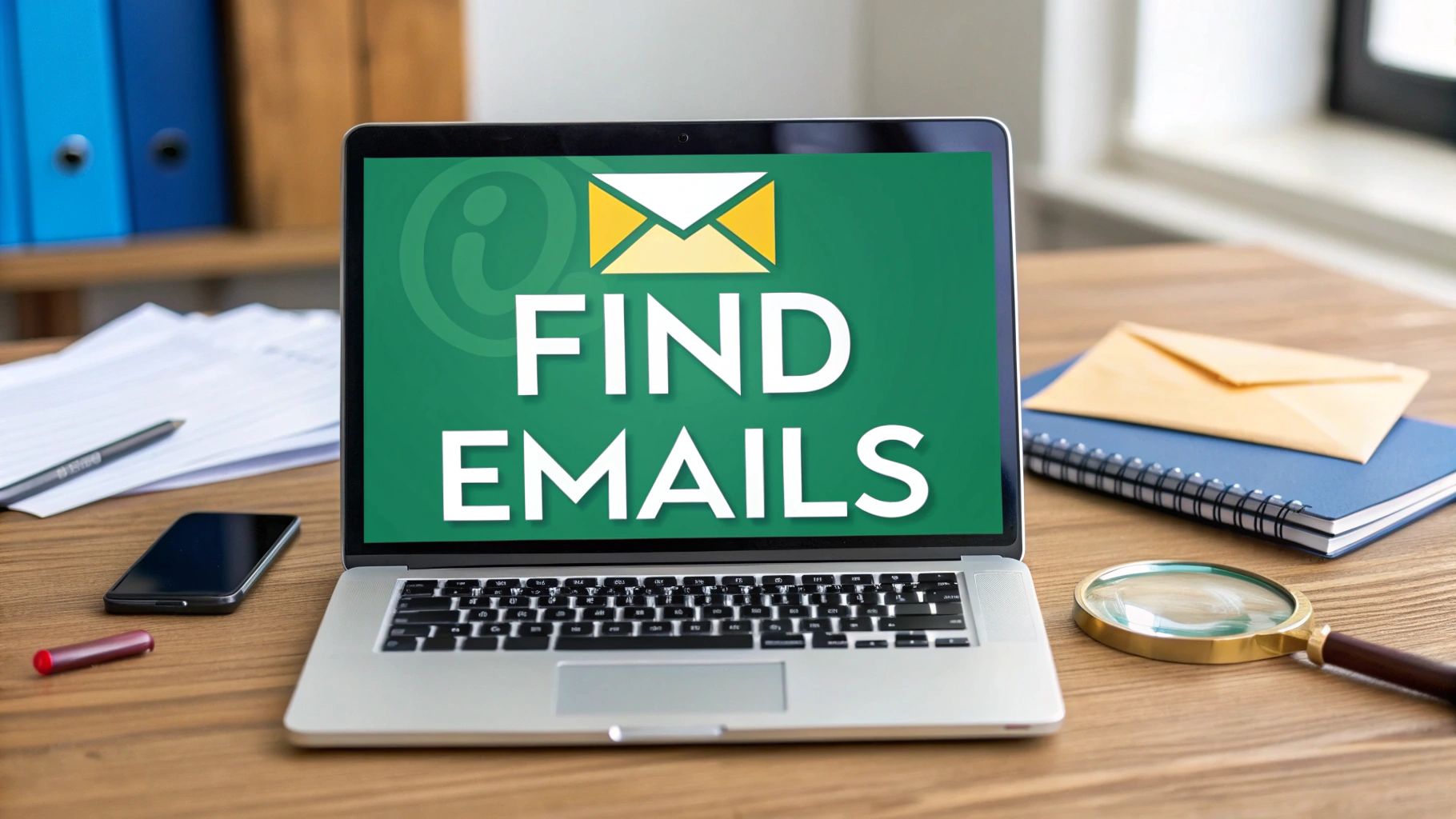Finding a specific company email address is the first, and most important, step to skipping those generic contact forms and getting straight to the decision-makers. It’s all about turning a cold outreach attempt into a warm conversation by landing your message in the right inbox. Get this right, and you're already halfway to unlocking new sales, partnerships, and collaborations.
Why Finding the Right Email Is a Game Changer
Before we jump into the "how," let's talk about the "why." It's easy to overlook just how critical finding the right email address is. In a world drowning in digital noise, a direct line of communication is gold. Those generic "info@" or "contact@" inboxes? They're often black holes, watched over by gatekeepers whose job is to filter you out.

The Power of a Direct Connection
When you have someone's direct email, you gain a massive advantage. You can actually tailor your message to them, referencing their specific role, a recent company win, or something they posted on LinkedIn. That level of personalization just isn't possible when you're filling out a generic web form.
A targeted email shows you’ve done your homework and that you respect their time. That simple act alone dramatically boosts your chances of getting a response and separates your message from the spam pile.
A verified email address is more than just a contact detail; it’s an invitation to a direct, professional conversation that can bypass corporate layers and accelerate business goals.
Building Relationships and Shortening Sales Cycles
At the end of the day, business is all about relationships. A direct email is the modern version of a personal introduction, opening the door for a real conversation. It's no surprise that email is still the top dog for professional communication. In fact, stats show that about 60% of consumers actually prefer email for brand communications, and that preference holds true deep inside the B2B world. You can dig into more of these email engagement statistics over on OptinMonster.com.
For sales pros, a direct email can mean a much shorter sales cycle. For marketers, it means a higher shot at a collaboration. For anyone doing outreach, it’s about turning a cold lead into a genuinely warm opportunity.
Uncovering Emails with Smart Manual Tactics
Before you jump into sophisticated software, some of the best ways to find a company email address involve a little old-fashioned digital detective work. These basic, no-cost methods are surprisingly effective and often get the job done when you only need to find a couple of key contacts.

The trick is knowing that most companies use a standard format for all their email addresses. If you have someone's name and their company's domain, you can make a few highly educated guesses.
Predicting Common Email Patterns
Let's say you want to reach John Smith at example.com. Instead of searching blindly, you can test a handful of common patterns. Most businesses stick to a single format to keep things consistent across the organization.
Take a look at the most common formats I see out in the wild.
Common Business Email Formats to Test
| Format Type | Example Structure | Likelihood of Use |
|---|---|---|
| First Name | john@example.com |
Common in startups |
| First Initial, Last Name | jsmith@example.com |
Very Common |
| First Name.Last Name | john.smith@example.com |
Very Common |
| Full Name | johnsmith@example.com |
Common |
Once you've got your list of potential addresses, a quick check is all you need. You can pop them into a free email verifier or even just the "To" field in a new Gmail message—hovering over a valid address will often reveal a user profile. For a more detailed walkthrough, our guide on how to find email addresses for free covers even more validation techniques.
Your best bet is often the simplest one. Guessing based on common patterns is a zero-cost strategy that can land you a correct email in less than a minute.
Leveraging Social and Web Clues
LinkedIn is your best friend here. It's the perfect place to confirm the exact spelling of someone's name and their official job title—the two key ingredients for making your educated guesses accurate.
Also, don't overlook the company's own website. A quick scan of the "About Us" or "Team" page can be a goldmine. Decision-makers are often listed right there, sometimes even with their direct email. If not, you can still grab their names and run them through the patterns we just covered.
These manual tactics might feel basic, but they're the foundation of any good, targeted outreach.
Using Specialized Tools for Instant Results
Let's be honest, hunting for emails one by one is fine when you need a handful of contacts, but it just doesn't scale. If you're building a serious list for a sales campaign, a marketing push, or a recruiting drive, you have to bring in the right tools. This is where specialized email finders completely change the game.
Services like EmailScout were built for this exact purpose: speed and accuracy. Instead of you playing a guessing game with email patterns, these platforms are designed to scan millions of public data points and internal databases almost instantly. The process is dead simple: you give it a name and a company, and the tool serves up a verified email in seconds.
The Clear ROI of Automation
Think about the time you get back. Finding just one person's email manually can eat up anywhere from five minutes to a half-hour if they're particularly hard to track down. A good tool can pull dozens of verified contacts in that same amount of time. That frees you up to focus on what actually moves the needle—writing that perfect outreach message.
The efficiency boost is massive. It empowers teams to:
- Build highly targeted prospect lists for sales cadences.
- Gather contacts for PR opportunities and marketing collaborations.
- Quickly source candidates for open roles without the manual grunt work.
For anyone in sales, marketing, or recruiting, the return on investment is immediate. All that time once lost to tedious searching is now spent building relationships and closing deals.
Here's a quick look at how clean and simple the interface is on an email finder like EmailScout. It really is just a few clicks.

This screenshot shows exactly how these tools can pull email addresses right from a professional networking profile, turning a static page into a goldmine of actionable leads. It shifts your whole workflow from a frustrating guessing game to a predictable, data-driven process.
It's More Than Just Finding Emails
The best platforms don’t just find emails; they validate them. This is a crucial step that manual searching almost always misses. A solid email finder runs real-time checks to confirm an address is active and can actually receive mail. This single feature drastically cuts down your bounce rate and helps protect your sender reputation.
For instance, when a tool finds "john.smith@example.com," it's not just confirming the format. It's often pinging the mail server to make sure that inbox actually exists. That extra layer of verification is what keeps your email campaigns healthy and effective. Taking a look at the best email finder tools on the market will give you a better idea of which features line up with your specific outreach goals.
At the end of the day, using a dedicated tool is about putting your outreach engine on steroids. It's hands-down the most reliable way to find a company email address at scale, making sure you connect with the right person, every time.
Alright, you've hunted down what looks like the perfect company email address. But hold on—the job's not done yet.
Finding the address is only half the battle. The next step is absolutely critical: you have to confirm it's actually deliverable. Skipping this check is a surefire way to torpedo your outreach efforts before they even get off the ground.

Here’s why. When you send a message to an invalid address, it creates a hard bounce. As your bounce rate climbs, email service providers like Google and Microsoft start paying attention. They see those bounces as a huge red flag—a classic sign of a spammer blasting messages to an old, purchased, or scraped list.
Why Verification Is Non-Negotiable
A high bounce rate directly poisons your sender reputation, which is basically a credit score for your email domain. If that score drops, your future emails—even the ones sent to perfectly good addresses—are far more likely to get routed straight to the spam folder. Poof. Gone.
This is exactly why you need to improve email deliverability by making sure your list is clean. It’s a non-negotiable part of any serious outreach strategy.
Think of email verification as quality control for your outreach. It ensures your messages have the best possible chance of being read, protecting your brand's reputation with every email you send.
The quality of your list makes a massive difference. Recent stats show that companies sending over a million emails a month can see inbox placement rates as low as 27%. In contrast, smaller-scale senders often hit over 50%. A clean list really matters.
The good news is that modern tools like EmailScout often build verification right into their process, confirming an email is active before you even think about hitting "send." Our own guide on how to verify an email address gets into the technical weeds, but the takeaway is simple: always, always verify.
Ethical Outreach and Best Practices
Knowing how to find a company email address is one thing; knowing what to do with it is another. Let's be clear: finding an email grants you access, not permission to spam.
Think of every message you send as an invitation to a professional conversation. It's not just another number to blast in a campaign. This isn't just about good manners—it’s about staying on the right side of the law. Regulations like the CAN-SPAM Act in the U.S. and GDPR in Europe have sharp teeth. Violations can get expensive fast, with potential fines reaching up to $53,088 per email under CAN-SPAM alone.
Crafting Emails People Actually Read
The secret to successful outreach is ditching the generic templates. A cold email that gets a reply is one that provides real value upfront and proves you've done your homework on the person and their company.
Here’s what works:
- Personalize Beyond Their Name: Go deeper than just
Hi {first_name}. Reference a recent project they launched, a smart point they made in a LinkedIn post, or a company milestone. It shows you’re actually paying attention. - Lead with Value: Don't just ask for something. Offer a useful insight, share a resource you think they'd appreciate, or propose a solution to a problem you know they're facing.
- Always Include an Opt-Out: This one is non-negotiable. Making it dead simple for someone to unsubscribe is a legal requirement and a basic sign of respect.
The goal isn't just to get a response; it's to build a bridge. A thoughtful, well-researched message builds relationships, while a spammy one burns them down permanently.
The inbox is an incredibly crowded space. With an estimated 376 billion emails sent every single day worldwide, your message has to earn its right to be there. (You can find more on that staggering number over at Hostinger.com). Responsible, respectful outreach is how you stand out for all the right reasons.
Your Top Email-Finding Questions, Answered
Even with the best tools in your arsenal, you're bound to have questions when you're on the hunt for a company email address. I get it. Let's walk through some of the most common ones I hear to help you fine-tune your outreach.
Is It Actually Legal to Find and Use a Company Email for Outreach?
The short answer is yes, as long as it's for legitimate business-to-business purposes. But—and this is a big but—you have to play by the rules. That means complying with anti-spam laws like CAN-SPAM in the U.S. and GDPR in the E.U.
These regulations aren't just red tape. They mean your message has to be directly relevant to the person's job, you must clearly state it's an ad, include your physical address, and give them a dead-simple way to opt out. The fines for ignoring these rules are no joke, so always prioritize ethical, transparent communication.
The golden rule here is simple: respect the inbox. Make your outreach a targeted, valuable proposition, not just another piece of unsolicited junk mail. This protects both you and the person you're trying to reach.
What’s the Most Reliable Way to Find a Company Email?
For sheer speed and accuracy, nothing beats a dedicated email finder tool. Manual searching definitely has its moments, especially if you only need one or two emails. But when you need results you can count on, and you need them fast, a specialized tool is the way to go.
These tools tap into massive databases and use real-time verification to give you accurate results in seconds. The whole point is to spend less time digging for contacts and more time actually connecting with them, especially when you're building out a sales or marketing list.
What Should I Do If I Just Can’t Find Their Email?
It happens. Sometimes, an email is just too well-hidden. When you've hit a dead end after trying a few methods, it's time to switch gears.
A fantastic alternative is to connect with them on a professional network like LinkedIn. Don't just send a cold connection request. Engage with their content first, build a little rapport, and then politely ask for their contact details.
Another tactic that works more often than you'd think is reaching out to a generic company email, like info@company.com or contact@company.com. A simple, polite message explaining who you're trying to reach and asking to be pointed in the right direction can often get you exactly where you need to go.
Ready to stop guessing and start connecting? EmailScout gives you the power to find verified email addresses in seconds, directly from your browser. Try it for free and supercharge your outreach today.
